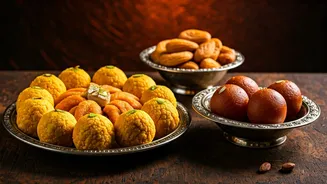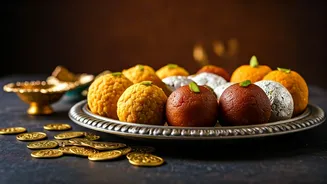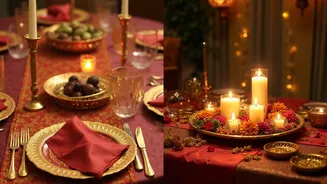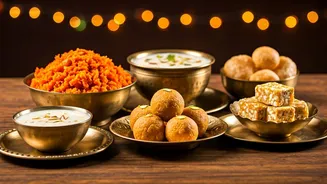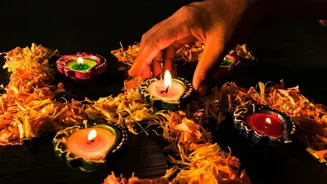Sweet Treats for Gods
The tradition of offering sweets during Diwali stems from the belief in their ability to please the deities, inviting blessings and prosperity into the home.
These sweets often symbolize sweetness in life and the hope for a prosperous year ahead. Ladoo, a ball-shaped sweet, is a favorite of Lord Ganesha, often made with gram flour, sugar, and ghee. Another popular offering is barfi, a milk-based sweet made with condensed milk and sugar. It is sometimes flavored with cardamom and nuts. Jalebi, a deep-fried, syrup-soaked sweet, represents the sweetness of life and is often associated with Lakshmi, the goddess of wealth. Kaju katli, a cashew-based fudge, signifies opulence and is a symbol of prosperity during the festival. These sweets are not just offerings; they are an integral part of the Diwali festivities, bringing joy and happiness.
Savory Dishes Too
Besides sweets, savory dishes also play a vital role in Diwali celebrations, offering a balance of flavors and textures. The food is carefully prepared to represent the diverse aspects of life and the richness of the festival. Samosas, a fried pastry filled with spiced potatoes, are a classic favorite, representing the joy and satisfaction derived from the festival. Mathri, a flaky biscuit, offers a crunchy texture and is often served with tea. Namak para, a savory snack, balances the sweetness of the other offerings. Pakoras, vegetable fritters, provide a flavorful and crispy addition to the food spread. These savory dishes complement the sweets, creating a balanced and complete offering to the deities.
Fruits of Festivity
Fruits are often included in Diwali offerings, symbolizing health, prosperity, and the bounty of nature's blessings. They represent the fruits of good deeds and the hope for a bountiful future. Bananas, with their easily available nature and symbolism of prosperity, are commonly offered. Pomegranates, representing abundance, are often included, their vibrant seeds symbolizing the richness of life. Grapes, enjoyed for their sweetness and juicy texture, also find their place in the Diwali offerings. These fruits, offered to the deities, reflect the gratitude for nature's gifts and the anticipation of a prosperous new year.
The Significance of Rice
Rice, a staple food in many Indian households, holds a special place in Diwali celebrations, representing abundance, prosperity, and the continuity of life. Offering rice to the deities is a way of seeking blessings for a prosperous harvest and a life filled with abundance. Cooked rice is often offered in various forms, such as plain rice, or as part of a more elaborate dish like kheer (rice pudding). Rice is an essential offering and a symbol of auspiciousness during Diwali, representing nourishment, growth, and the cycle of life.
Spices and Herbs
Spices and herbs add a special dimension to the Diwali offerings, enhancing the flavors and adding layers of symbolism. Each spice carries its own significance, adding depth to the festive experience. Cardamom is a spice often used in sweets. Turmeric, known for its auspicious properties, is sometimes used in sweets and dishes. Cumin, appreciated for its digestive properties, is used in many savory snacks. The aromatic and flavorful spices are not only added for taste; they also represent good health, well-being, and the divine energy invoked during Diwali.
Drinks for the Gods
Beverages are also offered as part of the Diwali puja, representing refreshment and the sustenance needed for life. They represent the life-giving aspect of the gods' blessings. Milk, considered pure, is often offered, often sweetened with sugar or made into kheer. Fruit juices, often made from seasonal fruits, represent the vitality of life. Water, considered a symbol of purity, is always a crucial offering. The offering of these drinks ensures that the deities are refreshed and acknowledges the necessity of nourishment and vitality in our lives.
The Symbolic Thali
The Diwali offerings are often presented on a thali, a plate, as a symbol of unity and completeness. It embodies the harmonious blend of different elements. The thali usually includes a mix of sweets, savories, fruits, and other items, all arranged to create a visually appealing offering. The arrangement of the thali is a symbolic representation of abundance, representing the completeness of life. The thali not only offers the food but also showcases the respect and reverence for the deities, making the offering even more meaningful.
Significance of Offerings
The act of offering food to Goddess Lakshmi and Lord Ganesha during Diwali is deeply rooted in Hindu traditions, symbolizing gratitude, respect, and devotion. It reflects the belief in the gods' ability to bless devotees with prosperity, health, and happiness. Each offering represents specific prayers, acknowledging different aspects of life and the divine presence. The act of offering food demonstrates humility and thankfulness for the blessings received. This practice is a central part of Diwali, fostering spiritual connection and the sharing of blessings.
Preparation and Rituals
Preparing the food for Diwali offerings is a sacred process that involves several rituals. The preparation is usually done with clean hands and a pure heart, signifying the purity of the offerings. Often, the food is prepared fresh on the day of the puja. Before offering, the food is often blessed by a priest or a family elder. Mantras are chanted to invoke the presence of the deities. The food is then carefully placed before the idols, and prayers are offered. These rituals enhance the spiritual significance of the offerings and create a more meaningful connection with the deities.
